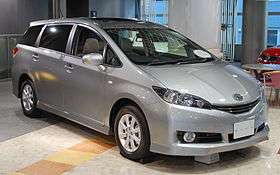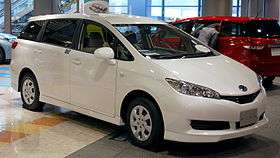Toyota Wish
| Toyota Wish | |
|---|---|
 | |
| Overview | |
| Manufacturer | Toyota Motor Corporation |
| Production | 2003–present |
| Body and chassis | |
| Class | |
| Layout | FF layout |
The Toyota Wish (stylized as Toyota WISH) is a compact MPV produced by Japanese automaker Toyota since 2003. It is available as a six and seven-seater, equipped with either a 1.8 or 2.0-litre gasoline engine. It is positioned below the Ipsum and above the Spacio in the Toyota minivan range.
Apart from Japan, the Wish is also assembled in Thailand (for Malaysia, Singapore) and in Hong Kong and Taiwan.
First generation (AE10; 2003–2009)
| First generation (AE10) | |
|---|---|
_1.8A_wagon_(2016-01-03)_01.jpg) | |
| Overview | |
| Manufacturer | Toyota |
| Production |
|
| Assembly | |
| Body and chassis | |
| Class | Compact MPV |
| Layout | |
| Related | |
| Powertrain | |
| Engine | |
| Transmission |
|
| Dimensions | |
| Wheelbase | 2,750 mm (108.3 in) |
| Length | 4,560 mm (179.5 in) |
| Width | 1,695 mm (66.7 in) |
| Height | 1,590 mm (62.6 in) |
_1.8A_wagon_(2016-01-03)_02.jpg)
2003
The Wish was developed under code name "760N" by the team, led by Chief engineer named Takeshi Yoshida and was introduced to the public for the first time at Tokyo Motor Show in October 2002 (Commercial vehicles & welcab show) and then launched in Japan in January 2003, under a massive publicity campaign with Japanese singer Hikaru Utada. The TV commercial features her song Colors, which coincides with the launch of her new CD-single. The car was marketed under the "Wish Comes True" slogan.
Codenamed ZNE10G (FWD) and ZNE14G (4WD), it uses a 1.8 L 1ZZ-FE engine, producing (JIS) 132 PS and 170 N·m (125 lb·ft). It is only available with four-speed automatic. A 2.0 L version (codenamed ANE11W for the six-seater version and ANE10G for the seven-seater version) was launched in March 2003. Equipped with the 1AZ-FSE direct-injection engine, it has (JIS) 155 PS (114 kW) and 192 N·m (142 lb·ft). Variants with the 2.0 D-4 engine are only available with a CVT gearbox.
The WISH was extremely successful in its home market, and is frequently seen on the Top 5 on the 30 bestseller list each months. It has also made shockwave to its competitors, such as the Honda Stream & Mazda Premacy or Mazda 5 to changing its market positioning.
The Toyota Wish was also launched as a locally assembled model in Thailand towards the end of 2003 (Dec.2003). The Wish in Thailand is very similar to the Japanese version, except for a few differences:
- Models across the range get the 2.0Z fenders.
- Standard 17 inch wheels across the range (Same design as the one used on the 2.0Z)
- Same 2.0 1AZ-FE engine as the ASEAN Camry instead of the 1AZ-FSE
- No privacy glass (excluding the grey-import variants)
- Leather upholstery as standard on the 2.0Q
- The rear Double wishbone suspension of 4WD models in Japan was fitted with 2WD model in Thailand as standard. (no Torsion beam rear suspension in Thai version).
The Thailand production was stopped in 2009, due to its unpopularity.
2004
The Wish was launched in Taiwan in November 2004. For this market, the car is marketed under the "No Rules!" slogan and the TVCM is shot in New York. The Taiwanese version shares the same engine as the Thailand model, which means missing out on Toyota's D-4 technology. The Taiwanese assembled version have some styling differences: a new front end, redesigned rear LED taillights, reflectors recessed into the rear bumper, body color/chrome side rubbing strips and a cleaner chrome rear plate garnish. The WISH badging is not an integral part of the garnish, unlike the Japanese-spec model. Equipment may include parking sensors, dual moonroof and leather seats. Another aspect unique to the Taiwanese Wish is that it can be specified with a beige interior color scheme unlike its Japanese and Thai-built counterparts.
2005
The car was a huge success in Japan, and featured in the best sellers chart regularly, no mean feat for an MPV. The Toyota Wish was updated at the end of 2005 with the introduction of a facelifted model. The original car was fundamentally well designed and that meant that few changes were necessary. Cosmetic changes to the headlights, bumpers, LED tail-lights and dashboard were made, together with revised switchgear for the climate control and automatic transmission (The 2.0Z received a seven-gear transmission.) As the changes were minor the fuel consumption figures, which are the best in the compact MPV class, remain the same. The 2005 Wish was also the third model to be sold exclusively through Toyota's NETZ dealer network, hence the replacement of the Wish's signature "W" front emblem with a generic NETZ oval (As seen on the 2005 Vitz & Ist.). Feedback on the electronic throttle control has been mixed, with claims that the original throttle system used in the 2003 car is quicker off the mark. The drivetrain and engines remained the same.
For model year 2007 on Japanese models only, G-BOOK, a subscription telematics service, is offered as an option.
2008
In Singapore, the local distributor started to bring in the Toyota Wish later in 2008 as an compact MPV to buyers there.[2] Instead of the generic NETZ oval emblem found on the parallel imported Wish, the local distributor replaced the oval NETZ emblem with the Toyota one. Sold as the Wish Aero Tourer to distinguish itself from the parallel import Wish; additional, otherwise optional accessories such as a 5-piece bodykit inclusive of a high mount, rear LED brake light, reverse camera, side mirror indicators, illuminated scuff plate, window visors and a muffler cutter is featured as standard equipment. Previously, the Wish was only sold by parallel importers.
Second generation (AE20; 2009–present)
| Second generation (AE20) | |
|---|---|
 | |
| Overview | |
| Manufacturer | Toyota |
| Production | 2009–present |
| Assembly |
|
| Body and chassis | |
| Class | Compact MPV |
| Layout | |
| Related | |
| Powertrain | |
| Engine | |
| Transmission |
|
| Dimensions | |
| Wheelbase | 2,750 mm (108.3 in) |
| Length | 4,590 mm (180.7 in) |
| Width | 1,695 mm (66.7 in) |
| Height | 1,590 mm (62.6 in) |
| Curb weight | 1,355–1,380 kg (2,987.3–3,042.4 lb) |
The second-generation Wish has been available for the Japan domestic market since March 2009. In Japan, it is available at Toyota dealership Toyota NETZ. It is powered by Toyota's Dual VVT-i 2ZR-FAE and 3ZR-FAE engines. All models come with Toyota's 7-speed Super CVT-i transmission. The exterior dimensions remain similar to the previous generation, except for the length which has increased slightly.
The second generation Wish continues to be sold outside of the Japanese market in Hong Kong, Singapore[4] and Taiwan.
The Wish was updated at the end of 2013 with the introduction of a facelifted model. Cosmetic changes to the headlights and rear lamps featured LED insets, revised front grille, rear tailgate garnish and dashboard meter cluster were made.
Body styles
- 2WD
| Chassis code (DBA-) | ZGE22W-HWXQP | ZGE20W-HPXSP | ZGE20G-HPXGP | ZGE20G-HPXNP |
|---|---|---|---|---|
| Model | 2.0Z 2WD | 1.8S 2WD | 1.8G 2WD | 1.8X 2WD |
| Engine | 3ZR-FAE | 2ZR-FAE | 2ZR-FAE | 2ZR-FAE |
| Seats | 6 | 7 | 7 | 7 |
- 4WD
| Chassis code (DBA-) | ZGE25W-HPXSP | ZGE25G-HPXGP | ZGE25G-HPXNP |
|---|---|---|---|
| Model | 1.8S 4WD | 1.8G 4WD | 1.8X 4WD |
| Engine | 2ZR-FAE | 2ZR-FAE | 2ZR-FAE |
| Seats | 7 | 7 | 7 |
Engines
| Code | Years | Type/code | Power, torque@rpm |
|---|---|---|---|
| 2ZR-FAE (2WD) | 2009–present | 1,797 cc (109.7 cu in) (80.5x88.3mm) I4 | 144 PS (106 kW; 142 hp)@6400, 176 N·m (130 lb·ft)@4400 |
| 2ZR-FAE (4WD) | 2009–present | 1,797 cc (109.7 cu in) (80.5x88.3mm) I4 | 133 PS (98 kW; 131 hp)@6400, 164 N·m (121 lb·ft)@4400 |
| 3ZR-FAE | 2009–present | 1,986 cc (121.2 cu in) (80.5x97.6mm) I4 | 158 PS (116 kW; 156 hp)@6200, 196 N·m (145 lb·ft)@4400 |
Transmissions
| Model(s) | Type |
|---|---|
| 1.8S | Super CVT-i with 7-speed sport sequential shiftmatic with CVT sport mode |
| 1.8G, 1.8X | Super CVT-i with 7-speed sport sequential shiftmatic |
| 2.0Z | Super CVT-i with 7-speed sport sequential shiftmatic with dynamic sport mode |
Handling
All models include safety features such as ABS with EBD and BA. Additional features include TCS and VSC. All models include front ventilated and rear disc brakes with the exception of 1.8X 2WD (which include rear drum brakes).
|
References
- ↑ "國瑞汽車股份有限公司 KUOZUI MOTORS, LTD". Kuozui.com.tw. Retrieved 2010-10-17.
- ↑ "Borneo Motors brings in the Toyota Wish.". Retrieved 2008-06-01.
- ↑ "Japanese Production Sites" (Press release). Japan: Toyota. 2016-03-06.
- ↑ "Toyota launches the sequel to Singapore's most successful MPV". Retrieved 2009-10-31.
External links
| Wikimedia Commons has media related to Toyota Wish. |
